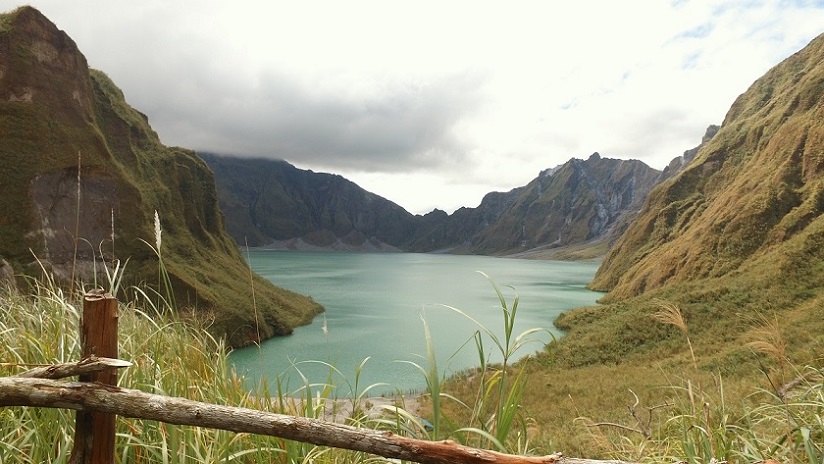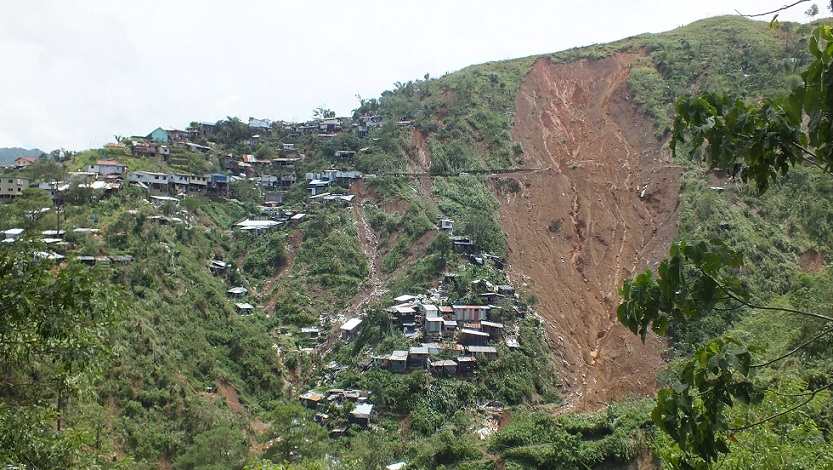
The trek to Pinatubo is more or less a 6-kilometer hike across the rocky riverbed of the Tarlac River. Photo by Terence Gonzalves.
Mt Pinatubo exploded in a spectacular display in 1991 and buried everything around it in ash and other volcanic debris. She heaved everything out with such force that the peak collapsed into itself, plugging the crater and creating a caldera that eventually filled with water.
Immediately after the eruption and some years later, thousands fled her wrath. These days, however, she is attracting a steady stream of hikers up her slopes. They pay homage to Crater Lake, a pool of what looks like liquid jade that is 600 meters at its deepest.
Getting to the view deck is an adventure in itself.
Mt Pinatubo is at the tri-boundary of the provinces of Zambales, Pampanga, and Tarlac but the most tourist-friendly point is from Capas town in Tarlac, through the military reservation where the Army’s Camp O’Donnell is located.
There are numerous tour organizers one can contact and various hotels or hostels to choose from. One can even try to go solo and organize his or her own trek. Whichever way, here’s what to expect for the day:

Hikers will be adequately challenged by the terrain – which shifts from sand to pebbles to unstable rocks – even if the incline is barely noticeable. Photo by Terence Gonzalves.
A registered organizer will give a briefing as early as 6 a.m. to explain how and why they strictly follow procedure. They will also explain the fees collected, where it goes, why it is collected.
Hikers over 40 years old have to get their blood pressure checked. A trained medical volunteer will be sent to accompany your trek – at an added cost – in case there are doubts about your fitness and health.
There is an 8 a.m. cut-off for tours. No group leaves past this time.
Sturdy sandals and socks are recommended. You will be crossing streams so expect your feet to get wet. On the other hand, closed footwear will provide protection should you accidentally stub your toes on the many, many rocks on the trail.
There won’t be any trees to provide protection from the elements. Put on sun block and a hat, wear comfortable clothes, and plan for hot and rainy weather. Bring drinks and snacks that will give you a quick energy boost but nothing so heavy.
A maximum of five tourists will be accommodated in a 4×4 jeep that will take you from base camp to the farthest point possible. The trail changes by the day and, in some cases, by the hour, depending on weather conditions.
The peak of Mt Pinatubo is 24 kilometers from base camp at the barangay. The jeep can take you as close as three kilometers on really good days in summer or as far as six kilometers when the weather isn’t as dry.
You will be trekking along the riverbed of the Tarlac River. You will be walking over sand, gravel, stones, and boulders. The slope has a very easy incline that you will barely notice it.
If on level ground you can cover six kilometers in just over an hour of brisk walking, expect to go slower in Pinatubo because of the terrain.
The more stops you make to rest and take photos, the longer the trek will take. Some make it in 1.5 hours. Some take as long as three hours to get to the top – senior citizen pace, as a guide would say in jest.
A hut marks the four-kilometer distance from the peak. The next rest stop marks the last kilometer and offers two toilets.
The last kilometer up to the peak is by far the most difficult you have to maneuver. You basically trace where the water originates so the trail is wet and slippery. Be extra careful.

A viewing deck was built on the edge of Mt Pinatubo’s caldera to providetourists a better view of Crater Lake, built when the volcano’s summit collapsed during the eruption and eventually filled with water. It is now becoming a popular attraction for local and international tourists. Photo by Terence Gonzalves.
The view deck is a small park where you can rest and comfortably soak in the majestic view. From here, there is stone staircase leading down the other side of the slope to Crater Lake, about 160 steps below. It can take as long as 10 minutes going down and twice that long coming back up.
Swimming is not allowed in Crater Lake. A drunk tourist drowned there years ago and authorities do not want a repeat of the tragedy. You can touch the water though.
Everyone – tourists and even the park staff – are allowed to stay there only until 12 noon. After that, everyone goes down. You risk getting stranded if you stay too late and caught by the afternoon showers.
It rains suddenly and without warning high in the mountain. The sudden showers can cause the mountainside streams to swell and become too dangerous to cross. You don’t want to get stranded there when it rains.
Do what your guide says. He’s been doing this for a long time so listen to his advice. He knows what he’s saying and doing.
Enjoy the experience.
(This story is produced by VERA Files under a project supported by the Internews’ Earth Journalism Network, which aims to empower journalists from developing countries to cover the environment more effectively.)


